
At the beginning of August Cairngorm Mountain (Scotland) Ltd, Highland and Islands Enterprise’s subsidiary which operates their business at Cairn Gorm, submitted a Planning Application to create a new beginner’s ski area (see here for planning documents). Parkswatch has covered this several times already (see here), (here) and (here) but the more you look at the application, the more issues it raises. In these posts therefore I have attempted to make an in depth review of the application and it’s supporting documents, highlighting mistakes and issues and raising some questions that need answered before a decision can be made.
Part 1. The Planning Application.
The information contained in the Planning Application form is misleading and contains several mistakes.
Page 1. Description of Proposal.
(1) The works site is described as being within the lower 300m of the slope. This is wrong as the access to Area N (see map above) is approximately 450m from the base of the Car park tow,
(2) The work is described as “smoothing and grading works to maximise snow making potential on the lowest mountain pistes”. This work is only required to reduce the cost of snowmaking for the beginner area. Beginners have learned to ski on Cairngorm with all its lumps, bumps and hollows for almost 60 years without any problems.
Page 3. Pre-application Discussion Details.
CMSL had site meetings with the Highland Council and the Cairngorms National Park Authority. The statement on the form claims: “The advice given is that these ground works are straightforward”. Advice from whom? The CNPA has said in numerous emails that “The above planning application raises a planning issue of “general significance” to the CNPA’s aims”.
Page 3. Site area.
The site area, according to the application, is 0.93 hectares or 9,300 sq. m. There is no indication if this is the work area or the sum of the areas to be bulldozed! I have however worked out that it is the whole site, although by my calculations, which are approximate, the area is actually 11,388sq.m., while the area being bulldozed is over 2928sq.m.
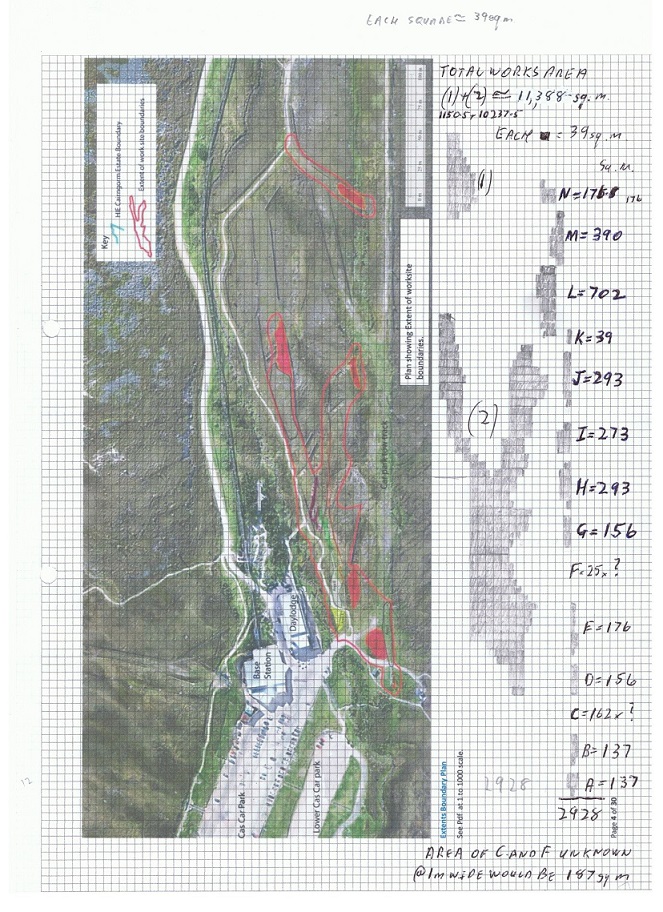
Due to lack of clarity in the application documents, it is not possible to measure areas C & F. However, their total length is 187m. If we assume that a vehicle working on these areas creates a track 3m wide then the area of C + F is 561sq.m., bringing the total to 3489sq.m.
Page 4. Water Supply and Drainage Arrangements.
“ Do your proposals make provision for sustainable drainage of surface water?” YES.
Assessment of Flood Risk.
“Do you think your proposal may increase the flood risk elsewhere?” NO.
Both these questions have a bearing on each other. The compaction that is going to occur when machinery is being used will allow water to run off more easily at times of heavy rain or thaw as will the new drainage pipes. This summer has seen numerous national instances of catastrophic rainfall and the consequences and yet, according to the information on page 8 “A Flood Risk Assessment”, is not considered applicable!
Part 2. Supporting Information.
Alongside the Planning Application form there is a separate document entitled “Supporting Information”.
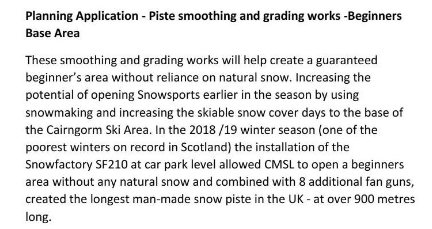
There are two obvious problems with this statement:
Firstly, there is no point in snowmaking if the weather is not suitable, that in itself would defeat the point of the “smoothing”, and the fan guns also need the right conditions, and,
Secondly, there is an assumption that the Snowfactory is going to operate without all the technical difficulties that it suffered in the trial of 2017/18 and again after its purchase for the 2018/19 season.
There is also the question as to how the snow fans will be powered, using diesel generators again, polluting the air, or will there be mains electric?
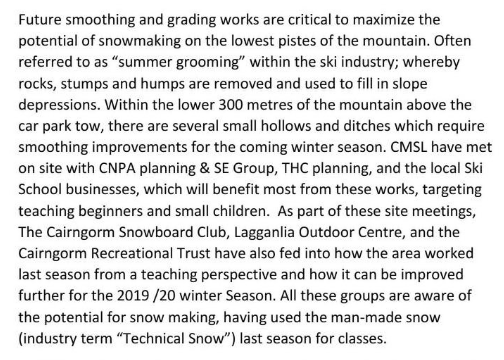
The first sentence implies that there will be further applications for bulldozing in the future. Is this why HIE/ CMSL aren’t producing the “Masterplan” that has been requested by the CNPA and promised for so long?
Further on its stated that “CMSL have met on site…..the local ski school businesses which will benefit most from these works.” How is this going to help the wider Strathspey area if this winter isn’t a vast improvement on last year? Oh, but “I’m all right Jack” seems to be the attitude of some! Where is the weather data which shows how likely a beginner’s ski area here will work and what was the consultation with other stakeholders and interested parties? After all the snow sports businesses are unlikely to provide an unbiased opinion which should have been balanced by engaging with the local conservation groups!
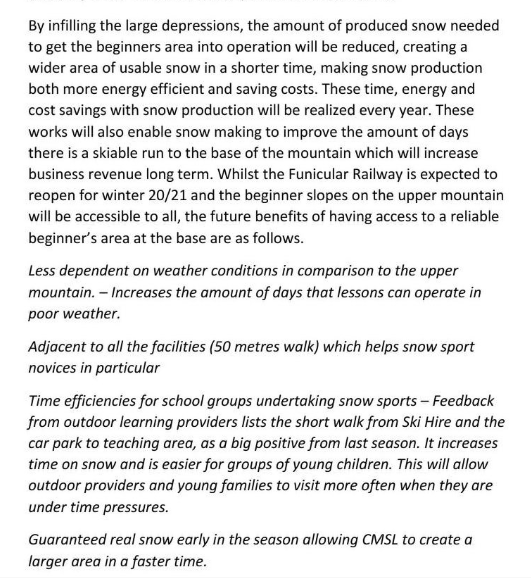
The SE Group report costed the bulldozing at £35,000 per hectare. As well as filling the depressions, a lot of snow production will be needed to cover the vegetation, which could be as much as 0.6m. deep At a cost of only £200-£400 per day, figures courtesy of Scottish Natural Heritage, heather cutting is a far cheaper option than filling in depressions and would allow the snow base to be built up quicker. For example, using the CMSL figure for the area covered by manufactured snow in the 2018/19 season, 668 square metres of vegetation averaging a depth of 0.6m. requires up to 400 cubic metres of snow to cover it. The same area with the vegetation cut back to ground level could be covered with as little as 0.15m of snow, which is only 100 cubic metres.
That is a substantial cost saving without destroying the base vegetation. Along with all the proposed cutting and filling to smooth the slope, there are other protruding bumps and boulders. Is this why the site application areas is so large? Machinery moving around the area will conveniently flatten everything not dug up.
CMSL report that 508cu.m. of snow was used to fill in “voids” last year and yet the amount of infilling required for depressions is only 114cu.m. That leads to the assumption that the remaining 394cu.m. was used to cover the vegetation over the 668sq.m. beginners area, very close to the figures I have worked out. That 394cu.m. of snow at a depth of 0.15m. could cover about 2,600sq.m.
Assumptions underpinning the Supporting Statement
There is also an assumption that this coming winter is going to produce better snow conditions than the last one, the Snowfactory is not going to encounter any problems and that the Funicular will be repaired in time for winter 2020/21, rather than removed.
The claims about “the future benefits of having access to a reliable beginners’ area at the base” are also misleading. How is this new area going to be less weather dependant? If it is windy or blowing a blizzard at the top it will almost certainly be the same lower down – Coire Cas is a windy place. Where is the site weather data to back this up? Only 50m walk to all the facilities! Yes, once you have skied down, but first you have to get up the 300m beginner slope!
Outdoor learning providers have said that the shorter traveling distance to the proposed new area is a big positive. So the beginners ski tow at the Shieling, installed just three years ago, and the Ptarmigan beginner areas are, according to them, a major drawback for the ski schools. Another argument against repairing the Funicular!
“Guaranteed real snow early in the season” is the claim, but only if the conditions are right.
Construction methodology

There is no indication here of what a “small digger” is, but an admission that it will cause compaction. Most people would think in terms of the kind of machine that you see working in someone’s garden, a machine which would be totally inappropriate for this work. Also there is no mention of the vehicle needed to move “cut material” around the works site to where it is needed.
The statement says that the “turf layer” will be removed to a minimum thickness of 300mm, although obviously that will not be possible over the whole site, but as much of the root systems and attached soil/peat as possible should be retained in thinner areas. It then says they will “reinstate the turf layer immediately”. Presumably heather will be part of the turves being relaid and unless this is removed then snow will still be wasted covering up the vegetation. This suggests that not all vegetation will be be replaced as claimed. Why is this not mentioned as it is all part of the “adopted company method statement”?
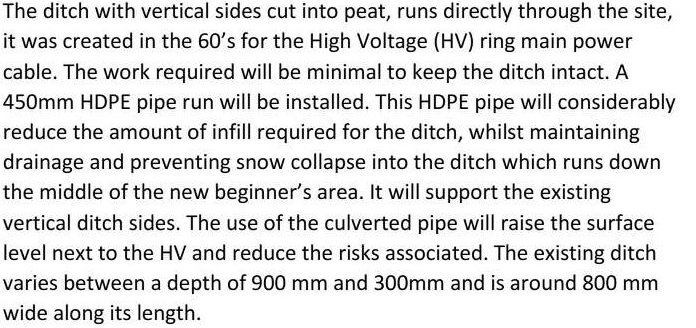
The paragraph about the HDPE drainage pipe is very vague and raises serious issues.
(1) There is no length given for the pipe run but I have measured it to be roughly 330m.
(2) “The pipe will considerably reduce the amount of infill required for the ditch”, but no information is provided to explain whether this will only be snow or infill from some of the bulldozing, and,
(3) How can a pipe with a diameter of 450mm support the sides of a ditch that is 800mm wide but in places is only 300mm deep meaning the pipe will be above ground level? The ditch will therefore have to be dug deeper over its full length to enable water to flow downhill and so that the piste basher spreading snow doesn’t break the new pipe.
I will cover the rest of the “Supporting Information” in the next part of this post but I hope I have shown here this is a very poor standard Planning Application.
3 Comments on “Cairn Gorm – the beginner’s ski slope planning application (1)”